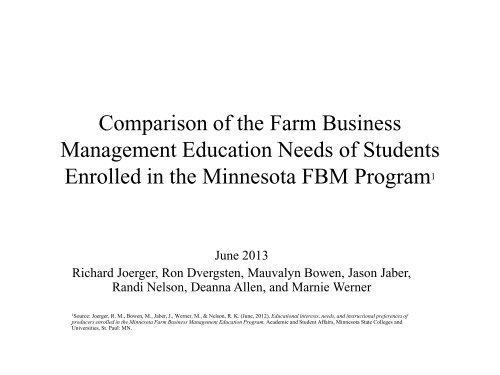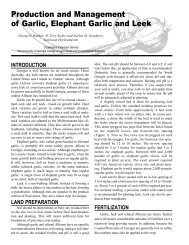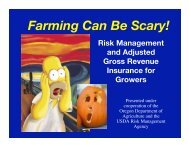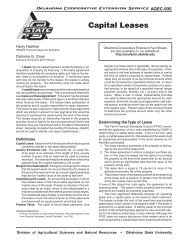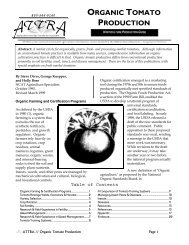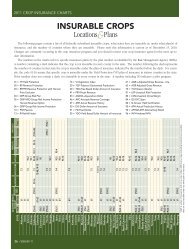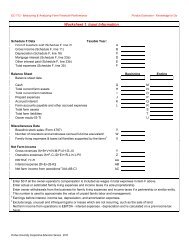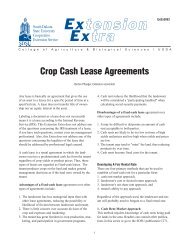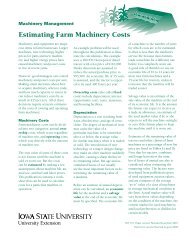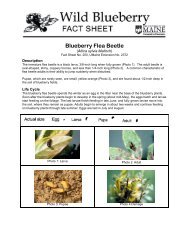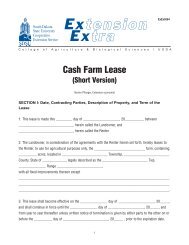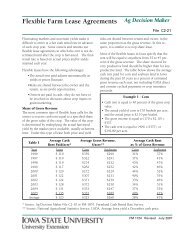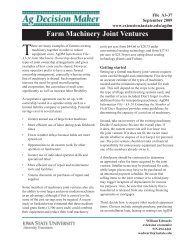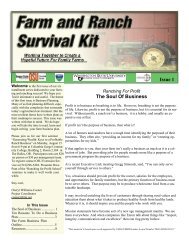Education Needs and Delivery Preferences of MN FBM Producers
Education Needs and Delivery Preferences of MN FBM Producers
Education Needs and Delivery Preferences of MN FBM Producers
You also want an ePaper? Increase the reach of your titles
YUMPU automatically turns print PDFs into web optimized ePapers that Google loves.
Comparison <strong>of</strong> the Farm Business<br />
Management <strong>Education</strong> <strong>Needs</strong> <strong>of</strong> Students<br />
Enrolled in the Minnesota <strong>FBM</strong> Program 1<br />
June 2013<br />
Richard Joerger, Ron Dvergsten, Mauvalyn Bowen, Jason Jaber,<br />
R<strong>and</strong>i Nelson, Deanna Allen, <strong>and</strong> Marnie Werner<br />
1<br />
Source: Joerger, R. M., Bowen, M., Jaber, J., Werner, M., & Nelson, R. K. (June, 2012). <strong>Education</strong>al interests, needs, <strong>and</strong> instructional preferences <strong>of</strong><br />
producers enrolled in the Minnesota Farm Business Management <strong>Education</strong> Program. Academic <strong>and</strong> Student Affairs, Minnesota State Colleges <strong>and</strong><br />
Universities, St. Paul: <strong>MN</strong>.
Acknowledgements<br />
• Minnesota <strong>Producers</strong><br />
• USDA Benchmarking Project<br />
• Minnesota State Colleges <strong>and</strong> Universities<br />
• Leadership Council for Management <strong>Education</strong><br />
• Minnesota <strong>FBM</strong> Instructors<br />
• Minnesota Center for Rural Policy <strong>and</strong> Development<br />
• Research Team
Topics<br />
• Background<br />
• Purpose <strong>and</strong> Objectives<br />
• Procedures<br />
• Findings<br />
• Conclusions <strong>and</strong> Recommendations
Background<br />
• The <strong>FBM</strong> <strong>Education</strong> Program has invested nearly 60 years in<br />
delivering business management education<br />
• Developed a curriculum in 2008-2009 using producer input to meet<br />
current producer educational needs<br />
• The 2010 Minnesota <strong>FBM</strong> <strong>Education</strong> Task Force explored strategies<br />
to increase producer access to educationally sound <strong>and</strong> fiscally<br />
efficient <strong>FBM</strong> programming<br />
Recommended program leaders investigate the delivery <strong>and</strong> business<br />
management education preferences <strong>of</strong> Minnesota producers.<br />
• 2011 – Study <strong>of</strong> Business <strong>and</strong> Production Management <strong>Education</strong> <strong>Needs</strong> <strong>and</strong><br />
Instructional <strong>Preferences</strong> <strong>of</strong> <strong>FBM</strong> Students <strong>and</strong> <strong>MN</strong> <strong>Producers</strong>.<br />
Technical Reports located at www.fbm.mnscu.edu
Purpose <strong>and</strong> Objectives<br />
• Purpose: determine the business management education<br />
needs <strong>of</strong> producers enrolled in the Minnesota Farm<br />
Business Management <strong>Education</strong> program.<br />
• Objective: to describe the needs, interests, <strong>and</strong><br />
preferences <strong>of</strong> producers regarding:<br />
Farm business management education need based upon:<br />
Type <strong>of</strong> farms<br />
Annual gross sales<br />
<br />
<strong>Education</strong> for employees <strong>of</strong> producers
Procedures<br />
• Descriptive survey design<br />
• Population - 2,850, Sample – 585, Usable - 404<br />
• Instrument: developed by the research team<br />
Likert-type items<br />
Open-ended questions<br />
Pilot test<br />
• Administered: hard copy <strong>and</strong> online<br />
• Data Analysis: Excel <strong>and</strong> SPSS
Findings<br />
• Participant Characteristics<br />
• Business Management <strong>Education</strong><br />
Type <strong>of</strong> Farm<br />
Gross Sales Income Levels<br />
• Employee Training
Selected Demographic Information<br />
N=404<br />
Characteristics N %<br />
Age in Years (M/SD) 46.9/12.3<br />
Gender - Male 387 95.8<br />
Highest level <strong>of</strong> education completed<br />
High School Graduate 103 25.5<br />
One-Year College Degree 51 12.6<br />
Two-Year College Degree 145 35.9<br />
Bachelor’s Degree 70 17.3<br />
Graduate Degree 4 1.0<br />
Work Part-Time Off the Farm 99 24.5
Farm Business Characteristics <strong>of</strong> <strong>FBM</strong><br />
Minnesota <strong>Producers</strong><br />
Form <strong>of</strong> Farm Business<br />
Business Characteristics N %<br />
Sole Proprietorship 304 75.2<br />
Corporation 44 10.9<br />
Legal Partnership 41 10.1<br />
Years Involved in Ownership in Farming<br />
M/SD 24.1 12.1<br />
Average Annual Farm Sales<br />
$100,000-$249,999 73 18.1<br />
$250,000-$499,999 117 29.0<br />
$500,000-$999,999 105 26.0<br />
$1,000,000-$2,499,999 60 14.9<br />
>$2,500,000 9 2.2
Farm Business Management <strong>Education</strong><br />
Interests <strong>and</strong> <strong>Needs</strong><br />
• Foundational – learning or re-learning<br />
introductory concepts <strong>and</strong> skills<br />
• Advanced - learning intermediate or advanced<br />
concepts <strong>and</strong> skills
Foundational Business Management <strong>Education</strong><br />
Topics Desired by <strong>FBM</strong> <strong>Producers</strong> (N=404)<br />
% Interest Rank<br />
Estate planning options 42.9 1<br />
Retirement plans’ impact on tax liability 42.1 2<br />
Risk management strategies 41.4 3<br />
Establishing goals 41.0 4<br />
New technologies 38.9 5<br />
Tax management strategies 1 38.8 6<br />
Farm community organization benefits 38.1 7<br />
Marketing plan 37.2 8<br />
Commodity markets 35.2 9<br />
Business transition options 35.2 9<br />
1<br />
Foundational <strong>and</strong> Advanced
Advanced Business Management <strong>Education</strong><br />
Topics Desired by <strong>FBM</strong> <strong>Producers</strong> (N=404)<br />
% Interest Rank<br />
Complete a farm business analysis 66.8 1<br />
Business analysis for decision making 65.0 2<br />
Budgets <strong>and</strong> break-even analyses 64.9 3<br />
Enterprise budgets & cash flow 63.8 4<br />
Capital <strong>and</strong> credit needs 63.4 5<br />
Financial statements to secure capital 62.4 6<br />
Financing capital assets 59.5 7<br />
Recordkeeping system 58.9 8<br />
Tax management strategies 1 55.3 9<br />
Creating a business plan 52.5 10<br />
1<br />
Foundational <strong>and</strong> Advanced
Foundational Business Management <strong>Education</strong><br />
<strong>Needs</strong> by Farm Type<br />
<strong>Education</strong> Topics<br />
Crops 1<br />
(N= 218)<br />
Livestock 1<br />
(N= 74)<br />
Crops &<br />
Livestock 1<br />
(N= 99)<br />
Rank Rank Rank<br />
Estate planning options 1 2 1<br />
Retirement plans on tax liability 2 3 3<br />
Establishing goals 3 7 6<br />
Tax management strategies 4 8<br />
New technologies 5 9 9<br />
Risk management assessment 6 1 2<br />
Farm & community organization benefits 7 5 5<br />
Recordkeeping system 8<br />
Marketing plan 9 7<br />
1<br />
Note: Crops -33.5-40.4% <strong>of</strong> producers; Livestock - 43.2 - 54.1%; Crops <strong>and</strong> Livestock – 36.4 - 41.4%
Advanced Business Management <strong>Education</strong><br />
<strong>Needs</strong> by Farm Type<br />
Crops 1<br />
(N= 218)<br />
Livestock 1<br />
(N= 74)<br />
Crops &<br />
Livestock 1<br />
(N= 99)<br />
<strong>Education</strong> Topics Rank Rank Rank<br />
Budgets, break-even calculations 1 4 1<br />
Annual business analysis 1 1 4<br />
Business analysis 3 2 1<br />
Capital <strong>and</strong> credit needs 4 5 4<br />
Financial statements to secure capital 4 6 6<br />
Enterprise budgets- cash flow 6 3 1<br />
Financing capital assets 7 8 7<br />
Recordkeeping system 8 6 8<br />
Create a business plan 8 12 11<br />
Commodity markets 8 15 11<br />
1<br />
Note: Crops – 50 – 62.8% <strong>of</strong> <strong>FBM</strong> <strong>Producers</strong>, Livestock 43.2 – 71.7%, Crops <strong>and</strong> Livestock – 50.5 – 70.7%
Foundational Farm Business Management <strong>Education</strong><br />
<strong>Needs</strong> <strong>of</strong> Minnesota <strong>Producers</strong> By Gross Sales<br />
$250-$499.99K<br />
(n= 117)<br />
$500 – $999.9K<br />
(n= 105)<br />
$1M – 2.49M<br />
(n= 60)<br />
>2.5M<br />
(n= 9)<br />
Estate planning options 52.1 39.0 25.0 33.3<br />
Retirement plans on tax liability 49.6 47.6 30.0 22.2<br />
Risk management assessment 48.7 35.2 23.3 33.3<br />
Tax management strategies 46.2 35.2 21.7 44.4<br />
Establishing goals 44.4 39.0 30.0 22.2<br />
New Technologies 44.4 41.0 18.3 33.3<br />
Farm, community organization benefits 42.7 41.0 36.7 22.2<br />
Create a business plan 42.7 36.2 18.3 22.2<br />
Marketing plan 41.0 33.3 25.0 55.6<br />
Communication Skills 41.0 33.3 25.0 33.3<br />
Commodity markets 39.3 32.4 25.0 33.3<br />
Business transition options 36.8 33.3 23.3 22.2<br />
Personal leadership benefits 35.9 33.3 26.7 22.2<br />
Recordkeeping system 32.5 30.5 25.0 55.6<br />
Business structure 32.5 31.4 21.7 33.3<br />
1 Note<br />
-<br />
Percentage <strong>of</strong> producers in the category
Advanced Farm Business Management <strong>Education</strong><br />
<strong>Needs</strong> <strong>of</strong> Minnesota <strong>Producers</strong> By Gross Sales<br />
$250-$499.99K<br />
(n= 117)<br />
$500 –<br />
$999.9K<br />
(n= 105)<br />
$1M –<br />
2.49M<br />
(n= 60)<br />
>2.5M<br />
(n= 9)<br />
Business Management Topics<br />
Budgets, breakeven calculations 66.7 1 62.9 1 70.0 1 88.9 1<br />
Annual business analysis 66.7 68.6 66.7 88.9<br />
Enterprise budgets- cash flow 65.8 61.9 63.3 100.0<br />
Business analysis 65.0 64.8 71.7 77.8<br />
Financial statements to secure capital 64.1 56.2 73.3 88.9<br />
Capital <strong>and</strong> credit needs 62.4 57.1 75.0 100.0<br />
Recordkeeping system 58.1 59.0 63.3 44.4<br />
Financing capital assets 55.6 56.2 75.0 88.9<br />
Tax management strategies 49.6 54.3 66.7 44.4<br />
Create a business plan 45.3 50.5 68.3 77.8<br />
New Technologies 44.4 50.5 71.7 55.6<br />
Commodity markets 43.6 50.5 66.7 66.7<br />
Marketing plan 42.7 50.5 63.3 33.3<br />
1 Note<br />
-<br />
Percentage <strong>of</strong> <strong>Producers</strong> in the category
Farm Business Management <strong>Education</strong><br />
“Hot Topics” By Farm Type<br />
Hot Topics<br />
Total<br />
Rank<br />
Crops<br />
Rank<br />
Livestock<br />
Rank<br />
Crop <strong>and</strong><br />
Livestock<br />
Rank<br />
Creating a marketing plan 1 1 5 3<br />
Exploring estate planning options 2 2 2 1<br />
Comprehensive recordkeeping<br />
system<br />
3 3 1<br />
Creating a farm business plan 4 4 4 3<br />
Using the annual farm business<br />
analysis reports to make decisions<br />
5 5 2 5<br />
Employment Practices 5 9
<strong>Education</strong> for Employees by Farm Type<br />
Employee Training Categories<br />
N<br />
Crop<br />
(n=218)<br />
Crop <strong>and</strong><br />
Livestock<br />
(n=99)<br />
Livestock<br />
(n=74)<br />
Employability Skills & Knowledge 74 1 32 22 20<br />
Safety, Communication, Attention to detail, Workplace<br />
behaviors, punctuality, Other (bilingual language,<br />
cleanliness, attitude, motivation, time management,<br />
workplace scheduling, proper behaviors, hiring the best)<br />
Mechanics Skills & Knowledge 18 8 7 3<br />
Equipment maintenance, st<strong>and</strong>ard operating procedure,<br />
license CDLs, equipment maintenance<br />
Livestock Care <strong>and</strong> Knowledge 9 0 3 6<br />
Livestock h<strong>and</strong>ling, animal husb<strong>and</strong>ry, herd health,<br />
livestock h<strong>and</strong>ling<br />
Business Knowledge & Skills 4 4 0 0<br />
Develop a business plan, financial management<br />
marketing, recordkeeping – Quickbooks<br />
1<br />
Note: number <strong>of</strong> producers who indicated a need.
Conclusions<br />
• There is need for specific topics <strong>of</strong> foundational <strong>and</strong> advanced<br />
farm business education programming for producers with<br />
different types <strong>of</strong> farms <strong>and</strong> levels <strong>of</strong> annual gross sales.<br />
• There is need for specific topics <strong>of</strong> education for the<br />
employees <strong>of</strong> Minnesota producers enrolled in the <strong>FBM</strong><br />
program.<br />
• There is an implied desire to have <strong>FBM</strong> instructors provide the<br />
instruction, thus warranting an organized approach to<br />
instruction. (Findings from the study indicate the <strong>FBM</strong><br />
instructor is the initial vendor used by producers.)
Recommendations<br />
• <strong>Producers</strong> enrolled in the Minnesota <strong>FBM</strong> Program be<br />
provided with quality business management education based<br />
upon their documented interests.<br />
• The Minnesota <strong>FBM</strong> Program provide education for<br />
employees <strong>of</strong> producers.<br />
• Program leaders provide pr<strong>of</strong>essional development <strong>and</strong> other<br />
resources needed by the instructors to effectively teach<br />
producers.
Bibliography<br />
Baharanyi, N. <strong>and</strong> R. Zabawa. 1996. “The Small Farmer <strong>and</strong> Social Issues.” Proceedings <strong>of</strong> the 1996 Small Farms Conference. Nashville, TN.<br />
Franz, N., et. al. (2010). How Farmers Learn: Implication for Agricultural Educators. Journal <strong>of</strong> Rural Social Sciences, 25(1), 2010, pp. 37–59.<br />
Gaul, S., Hochmuth, R.C., Israel, G.D., & Tredewell, D. (2009). Characteristics <strong>of</strong> small farm operators in Florida: Economics, demographics, <strong>and</strong><br />
preferred information channels <strong>and</strong> sources. (WCO88). Gainesville: Department <strong>of</strong> Agricultural <strong>Education</strong> <strong>and</strong> Communication, Florida<br />
Cooperative Extension Service, Institute <strong>of</strong> Food <strong>and</strong> Agricultural Sciences, University <strong>of</strong> Florida. Retrieved on March 15, 2011, from<br />
http://edis.ifas.ufl.edu/wc088.<br />
Israel, G.D. & Wilson, K.M. (2006). Sources <strong>and</strong> channels <strong>of</strong> information used by educational program clients. Journal <strong>of</strong> Applied Communications 90(4):<br />
55–78. Retrieved on March 31, 2011, from http://www.aceweb.org/archsite/JAC/pdf/JAC_pdfs/JAC9004/JAC9004_RS03.pdf.<br />
Joerger, R. M., Bowen, M., Jaber, J., Werner, M., & Nelson, R. K. (June, 2012). <strong>Education</strong>al interests, needs, <strong>and</strong> instructional preferences <strong>of</strong><br />
producers enrolled in the Minnesota Farm Business Management <strong>Education</strong> Program. Academic <strong>and</strong> Student Affairs, Minnesota State<br />
Colleges <strong>and</strong> Universities, St. Paul: <strong>MN</strong>.<br />
Joerger, R. M., Ipe, M., & Persons, E. (2000). An investigation <strong>of</strong> the nature, effectiveness, <strong>and</strong> impact <strong>of</strong> the Minnesota farm business management<br />
education program: The final report. College <strong>of</strong> Agriculture, Food, <strong>and</strong> Environmental Sciences, University <strong>of</strong> <strong>MN</strong>: St. Paul.<br />
Joerger, R.M., Nelson, R. K., Werner, M., Jaber, J., & Bowen, M. (June, 2012). Business <strong>and</strong> production management education interests, needs, <strong>and</strong><br />
learning preferences <strong>of</strong> Minnesota farmers. Academic <strong>and</strong> Student Affairs, Minnesota State Colleges <strong>and</strong> Universities, St. Paul, <strong>MN</strong>.<br />
Minniti, M. (with Bygrave, W.D., &Autio, E). (2005). Global Entrepreneurship Monitor 2005 Executive Report. Babson College, MA: USA, p.24.<br />
Senf, D., Maki, W., & Houck, J. P. (2008).The Economic Importance <strong>of</strong> Minnesota’s Food <strong>and</strong> Agriculture Industry. St. Paul, <strong>MN</strong>: Department <strong>of</strong><br />
Agricultural <strong>and</strong> Applied Economics, University <strong>of</strong> Minnesota.<br />
Tubene, S. <strong>and</strong> J. Hanson. 2002. “The Wholesale Produce Auction: An Alternative Marketing Strategy for Small Farms.” American Journal <strong>of</strong> Alternative<br />
Agriculture 17(1):18–23.<br />
United States Department <strong>of</strong> Agriculture.(1996). Food consumption, prices, <strong>and</strong> expenditures, 1996.Economic Research Service.SB 928.<br />
Vergot, P., Israel, G.D., & Mayo, D.E. (2005). Sources <strong>and</strong> channels <strong>of</strong> information used by beef cattle producers in twelve counties <strong>of</strong> the Northwest<br />
Florida extension district. Journal <strong>of</strong> Extension 43(2). Retrieved on March 19, 2012 from http://www.joe.org/joe/2005april/rb6.php.<br />
______, Minnesota Farm Business Management <strong>Education</strong>. Minnesota State Colleges <strong>and</strong> Universities, http://fbm.mnscu.edu/annualreports/index.htm<br />
______, <strong>FBM</strong> CurriculumBank, Minnesota State Colleges <strong>and</strong> Universities, http://mnfbm.curriculumbank.org/<br />
l
Questions <strong>and</strong> Discussion<br />
• Does updated curricula <strong>and</strong> instruction really make a difference?<br />
• What are the key barriers that limit producers from adopting<br />
instruction using the internet?<br />
• How do educators use this information when delivering<br />
instruction to producers?<br />
• How do we get access to the technical reports?<br />
• What are some <strong>of</strong> the advanced topics which should used in our<br />
instruction?<br />
• Thank You!


